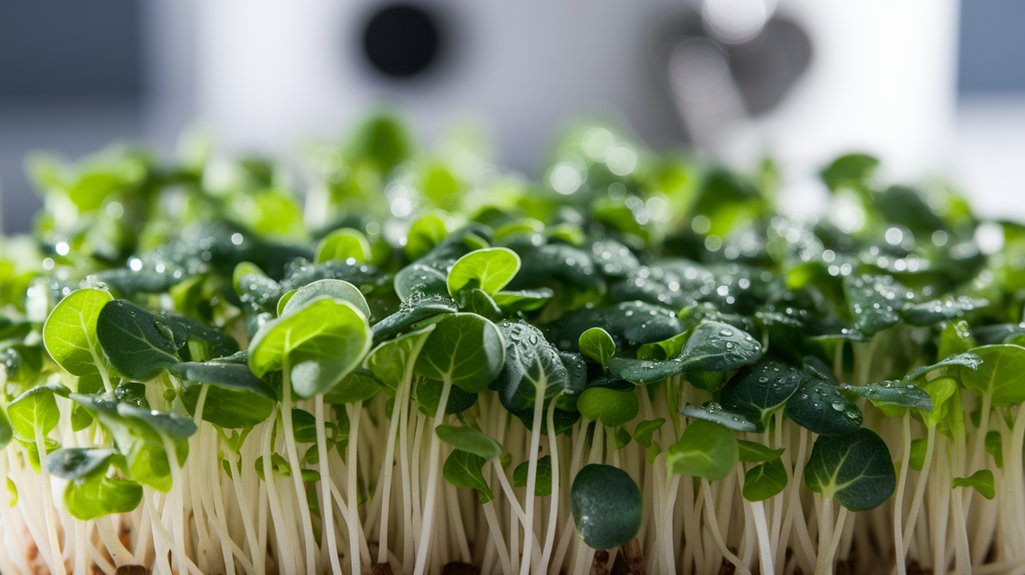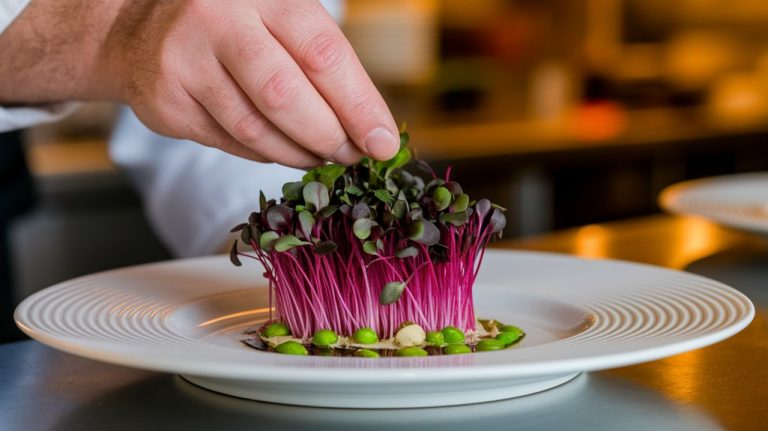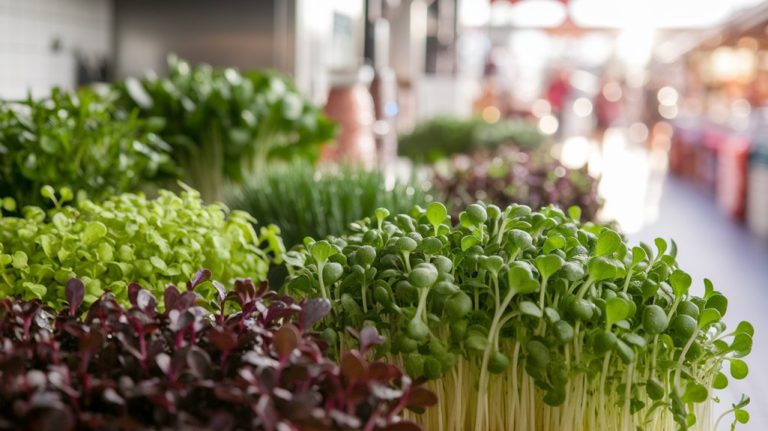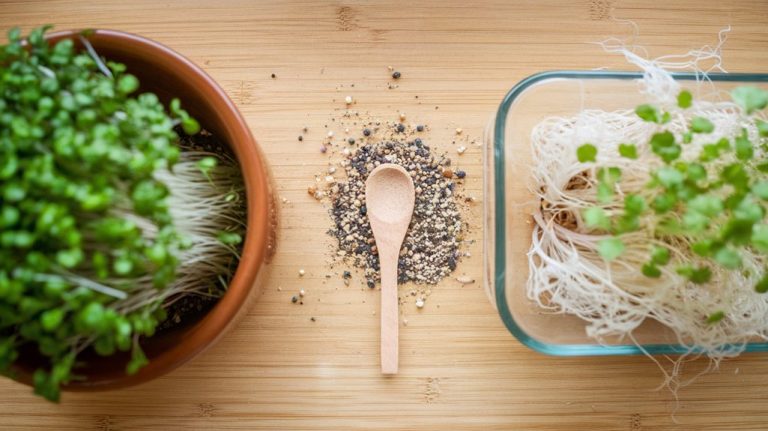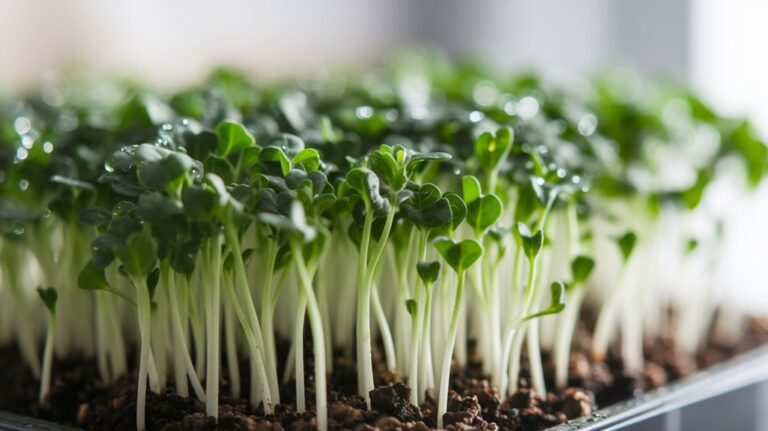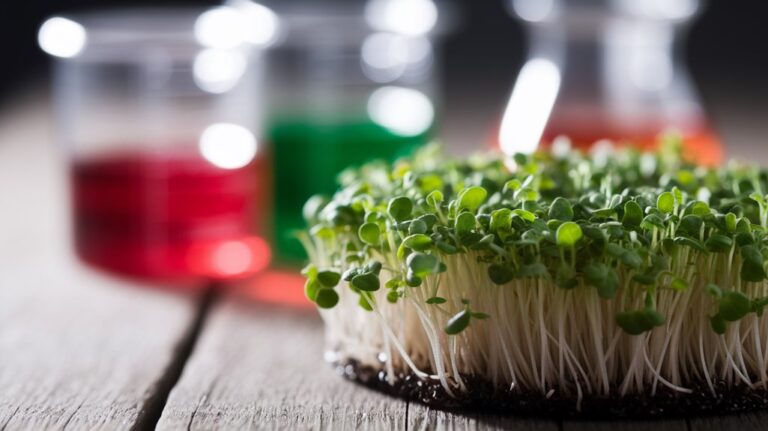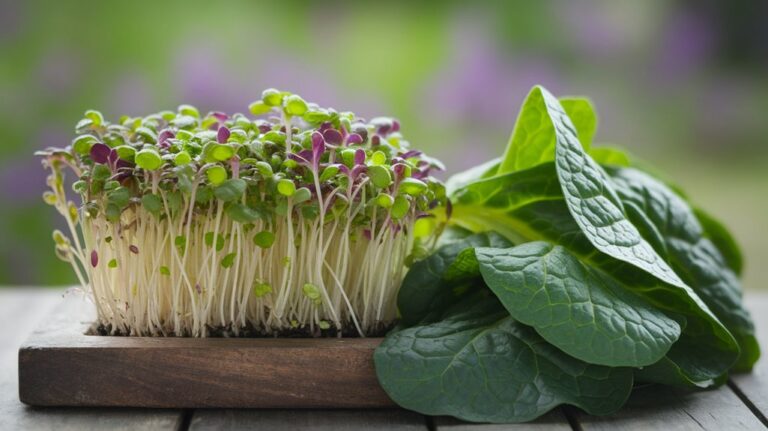The Science Behind the Crunch: Why Microgreens Taste So Good
Microgreens taste exceptional due to their unique combination of nutrient density and complex flavor compounds. I find that they’re packed with vitamins, minerals, and antioxidants, enhancing both taste and health benefits. The presence of terpenes and flavonoids contributes to their diverse flavors, while the crunchiness adds an enjoyable texture. Plus, growing conditions like light and moisture play a crucial role in flavor development. If you’re curious about how all these elements come together, there’s more to explore.
Key Takeaways
- Microgreens are rich in essential oils and amino acids, contributing to their intense and diverse flavors compared to mature plants.
- The presence of terpenes in microgreens enhances flavor complexity, providing unique notes that elevate culinary experiences.
- Varieties like mustard greens and basil are known for their distinct flavors, with mustard offering a peppery taste and basil providing sweetness.
- Optimal growing conditions, such as bright light and controlled moisture, intensify flavor development and enhance the overall taste.
- Microgreens’ vibrant colors and textures not only improve visual appeal but also signal freshness and enhance the dining experience.
The Nutrient Density of Microgreens
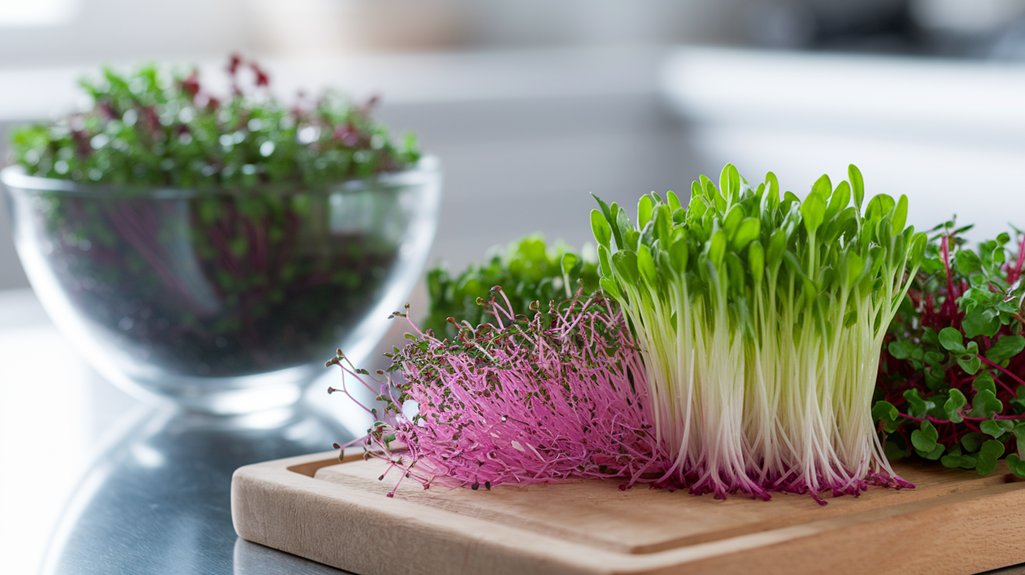
When I explore the nutrient density of microgreens, I often find myself amazed by their impressive profiles. Packed with vitamins, minerals, and antioxidants, these tiny greens provide a concentrated source of nutrition.
For example, varieties like kale and broccoli microgreens can contain higher levels of vitamins C, E, and K compared to their mature counterparts. Additionally, they’re rich in fiber and essential amino acids, which are crucial for overall health.
This nutrient density makes them an ideal choice for those seeking to boost their dietary intake without consuming large quantities. With their low-calorie count and high nutrient content, microgreens offer a powerful punch that can enhance any meal.
Incorporating them into my diet feels like a smart, health-conscious decision.
Flavor Compounds in Microgreens
Microgreens not only boast impressive nutrient profiles but also offer a diverse array of flavor compounds that can elevate any dish. These tiny greens are packed with essential oils, amino acids, and organic acids, contributing to their distinct tastes.
For instance, mustard greens provide a peppery flavor due to the presence of glucosinolates, while basil microgreens exude a sweet, aromatic profile attributed to their high volatile compounds. The concentration of these flavor compounds often surpasses that of mature plants, making microgreens a culinary powerhouse.
The Role of Terpenes and Flavonoids
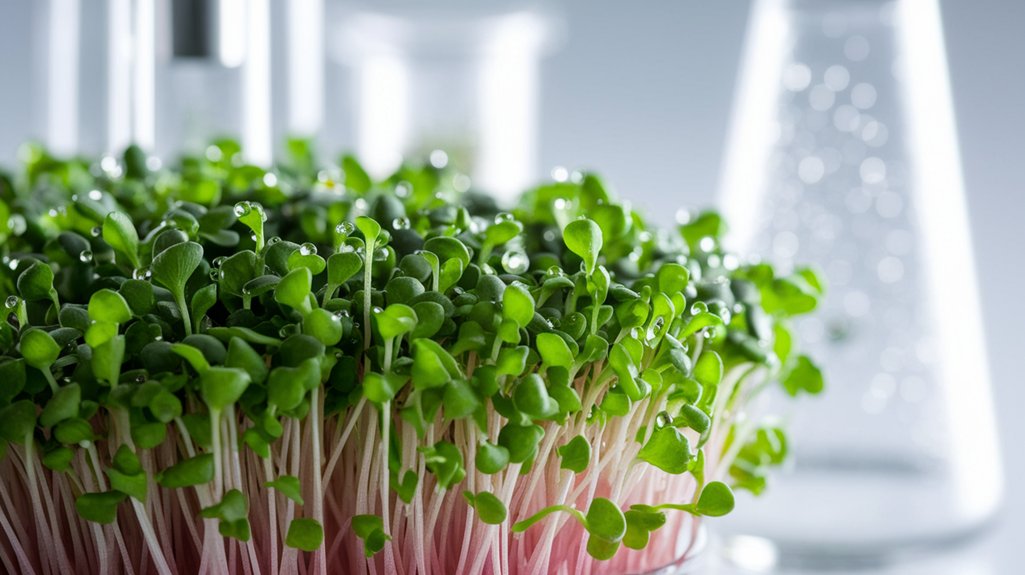
When I explore the flavors of microgreens, I often notice how terpenes enhance their overall profiles, adding depth and complexity.
Flavonoids not only contribute to taste but also offer significant health benefits, making these tiny greens even more appealing.
Understanding the role of these compounds can truly elevate our appreciation of microgreens.
Terpenes Enhance Flavor Profiles
While exploring the intricate flavors of microgreens, I’ve come to appreciate how terpenes and flavonoids significantly enhance their taste profiles.
Terpenes, the aromatic compounds found in many plants, are crucial for the distinct flavors we experience. For example, the citrusy notes in basil microgreens or the peppery bite of arugula can often be attributed to specific terpenes.
These compounds interact with our taste receptors, creating complex flavor sensations that elevate a dish. Moreover, terpenes can influence our perception of freshness and overall enjoyment.
They work synergistically with other compounds, making each microgreen variety unique. Understanding the role of terpenes helps me choose the right microgreens to complement various culinary creations, enhancing both taste and experience.
Flavonoids and Health Benefits
Although often overshadowed by terpenes, flavonoids play an equally vital role in the flavor and health benefits of microgreens. These compounds not only contribute to taste but also offer various health perks, such as antioxidant properties and anti-inflammatory effects.
Here’s a quick overview of some key flavonoids found in microgreens:
| Flavonoid | Health Benefits |
|---|---|
| Quercetin | Reduces inflammation and allergies |
| Kaempferol | Supports heart health and reduces cancer risk |
| Luteolin | Enhances brain function and reduces oxidative stress |
Incorporating microgreens rich in these flavonoids into your diet can enhance both flavor and overall well-being. So, next time you enjoy microgreens, remember their potent health benefits!
Aromatics in Microgreens Explained
Understanding the role of aromatics in microgreens is essential for appreciating their unique flavors and health benefits. Terpenes and flavonoids are the primary compounds responsible for the aromatic profiles in these tiny greens.
Terpenes, like limonene and pinene, impart citrusy and pine-like scents, enhancing the overall sensory experience. Meanwhile, flavonoids contribute not just color but also complex flavors, often yielding bitter or sweet notes that elevate dishes. This combination creates a multi-layered taste that can transform simple meals into gourmet experiences.
Additionally, both terpenes and flavonoids offer antioxidant properties, supporting health benefits alongside their flavor contributions. By understanding these components, I can better appreciate how microgreens enrich my culinary creations and my well-being.
Growing Conditions and Their Impact on Taste
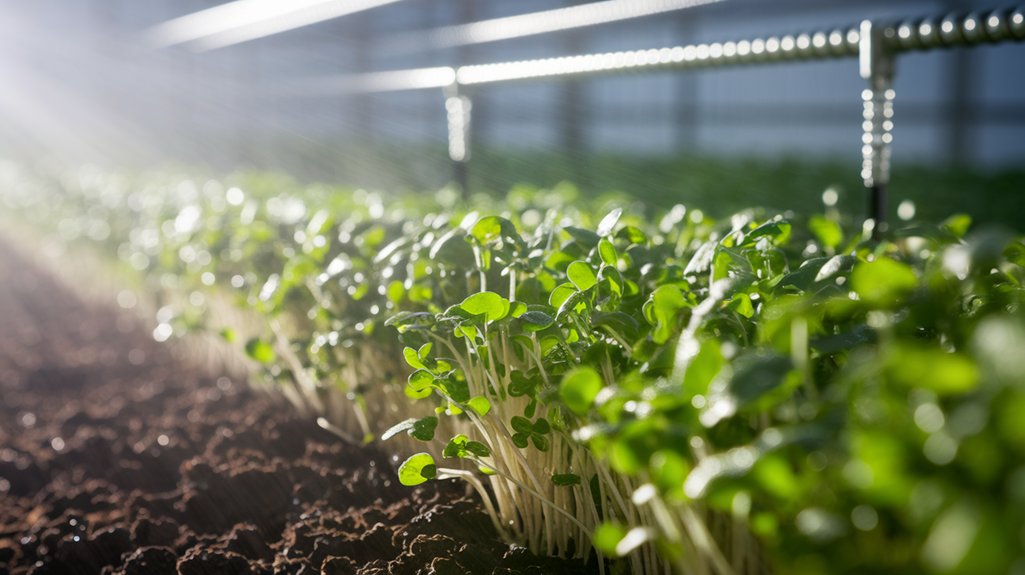
When I consider the taste of microgreens, it’s clear that their growing conditions play a crucial role in flavor development. Factors like light, temperature, and moisture significantly influence the compounds responsible for taste.
For instance, microgreens grown in bright light often develop more intense flavors due to increased photosynthesis, which boosts sugar and nutrient levels. Temperature also matters; warmer conditions can enhance the production of essential oils, leading to more robust flavors.
Additionally, the right moisture balance prevents stress in plants, allowing them to focus energy on flavor rather than survival. By controlling these variables, I can cultivate microgreens that not only taste better but also offer a more vibrant culinary experience.
Understanding these conditions truly elevates my gardening approach.
The Crunch Factor: Texture and Sensation
While the taste of microgreens often steals the spotlight, their texture plays a crucial role in the overall culinary experience. The crunch factor is essential; it adds a delightful contrast to softer ingredients.
When I bite into a microgreen, the crispness activates my senses, enhancing flavor perception. This texture is due to their cellular structure, which retains moisture and promotes that satisfying bite.
Additionally, the varying textures across different microgreen varieties contribute to a multi-dimensional eating experience. For instance, arugula microgreens deliver a more robust crunch compared to the delicate softness of pea shoots.
This interplay of textures not only elevates dishes but also makes eating microgreens a more engaging and pleasurable experience.
Microgreens and Culinary Applications
Microgreens offer an impressive range of flavor profiles, making them a versatile addition to various dishes.
In my experience, their culinary applications extend beyond mere garnish; they enhance both taste and nutrition.
Flavor Profiles Explored
How can a handful of microgreens elevate a simple dish into a culinary masterpiece? The secret lies in their diverse flavor profiles, which can enhance and transform any meal.
Consider the following:
- Peppery: Varieties like arugula and radish add a spicy kick, perfect for balancing rich flavors.
- Citrusy: Microgreens such as lemon balm and basil bring a refreshing brightness, ideal for salads and seafood.
- Earthy: Beets and sunflower microgreens provide a grounding taste that complements heartier dishes.
These tiny greens aren’t just garnish; they’re flavor powerhouses.
Culinary Versatility Unleashed
The culinary applications of microgreens extend far beyond mere garnishes; they serve as versatile ingredients that can elevate a variety of dishes.
I often incorporate them into salads, where their vibrant colors and textures add visual appeal and complexity. Their concentrated flavors make them ideal for enhancing soups and stews, providing a burst of freshness.
I’ve also discovered that microgreens can be blended into smoothies for an unexpected twist. When used as toppings for sandwiches or tacos, they introduce intriguing flavor notes.
They’re not just functional; they also contribute to the dish’s aesthetic. With countless varieties available, I can experiment endlessly, tailoring each dish to achieve a unique culinary experience.
Microgreens truly unleash a world of flavor possibilities.
Nutritional Enhancements Offered
While exploring the culinary uses of microgreens, I’ve been amazed by their impressive nutritional profile.
These tiny plants pack a punch, offering significant health benefits that enhance our meals. Here’s what I’ve discovered:
- Vitamins and Minerals: Microgreens are often richer in essential vitamins like C, E, and K, along with minerals such as calcium and magnesium.
- Antioxidants: They contain higher concentrations of antioxidants compared to their mature counterparts, helping combat oxidative stress.
- Flavor and Nutrients: Their intense flavors come with added benefits, making dishes not only tastier but also more nutritious.
Incorporating microgreens into my meals has transformed my approach to healthful eating, proving that small changes can yield substantial nutritional rewards.
Health Benefits Beyond Flavor
Although many people enjoy microgreens for their vibrant flavors, their health benefits extend far beyond taste. Packed with vitamins, minerals, and antioxidants, these tiny greens can significantly enhance your overall nutrition.
For instance, varieties like broccoli and radish microgreens are rich in sulforaphane, a compound known for its potential cancer-fighting properties. Moreover, the high levels of vitamin C and E found in microgreens contribute to immune system support and skin health.
They also offer anti-inflammatory effects, which can benefit heart health and reduce the risk of chronic diseases. Including microgreens in your diet can boost your nutrient intake without adding excessive calories, making them a smart choice for anyone seeking to improve their health holistically.
Frequently Asked Questions
How Can I Incorporate Microgreens Into My Daily Meals?
I love incorporating microgreens into my daily meals for their vibrant flavors and nutritional benefits.
I often sprinkle them on salads, blend them into smoothies, or use them as a garnish for soups. They add a fresh crunch to sandwiches and wraps, too.
For breakfast, I mix them into omelets or top my avocado toast with them.
Experimenting with different varieties keeps my meals exciting and nutritious, enhancing both taste and health.
Are There Any Microgreens That Are Toxic or Harmful?
Yes, some microgreens can be toxic or harmful if consumed in large quantities.
For instance, certain varieties of nightshade family plants, like tomatoes and eggplants, can produce alkaloids that may cause digestive issues. Additionally, it’s essential to ensure they’re grown in clean environments to avoid contamination.
I always research specific types before incorporating them into my meals, ensuring I choose safe and healthy options for my diet.
What Are the Best Microgreens for Beginners to Grow?
When starting out with microgreens, I recommend growing radish, sunflower, and pea shoots.
These varieties aren’t only easy to germinate, but they also thrive quickly, typically within 7 to 14 days.
Radish microgreens have a spicy kick, while sunflower offers a nutty flavor. Pea shoots are sweet and tender.
I’ve found these options to be forgiving for beginners, allowing us to enjoy fresh greens without too much hassle.
Happy growing!
Can Microgreens Be Grown Indoors Year-Round?
Absolutely, I can grow microgreens indoors year-round!
I’ve found that with the right lighting—like LED grow lights—and consistent moisture, they thrive regardless of the season.
I usually choose fast-growing varieties like radish or basil, which don’t require much space.
It’s a rewarding hobby that not only provides fresh greens but also brightens my indoor environment.
Plus, I enjoy experimenting with different flavors throughout the year!
How Do Microgreens Differ From Regular Greens Nutritionally?
Microgreens differ from regular greens in several nutritional aspects. They often pack higher concentrations of vitamins, minerals, and antioxidants, making them a powerhouse of nutrition in a small package.
For instance, I’ve noticed that certain microgreens, like broccoli and kale, can contain up to 40 times more nutrients than their mature counterparts. This means I can boost my diet easily by adding these tiny greens, enhancing both flavor and health benefits in my meals.
Conclusion
In conclusion, microgreens offer a unique blend of nutrient density, complex flavor compounds, and appealing textures that elevate their culinary appeal. The interplay of terpenes and flavonoids enhances their taste, while optimal growing conditions can further intensify these qualities. With their versatile applications in various dishes and impressive health benefits, microgreens truly stand out in the culinary world. Embracing these tiny powerhouses not only enriches our meals but also boosts our well-being.

